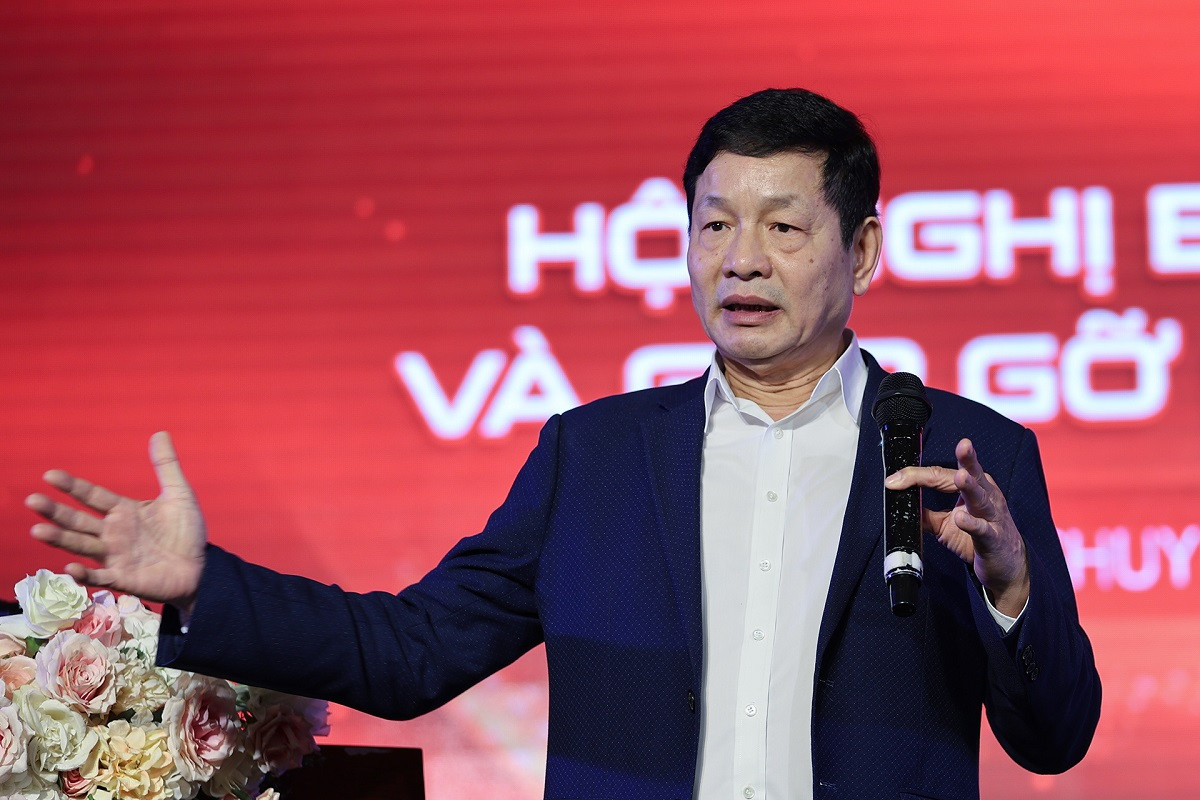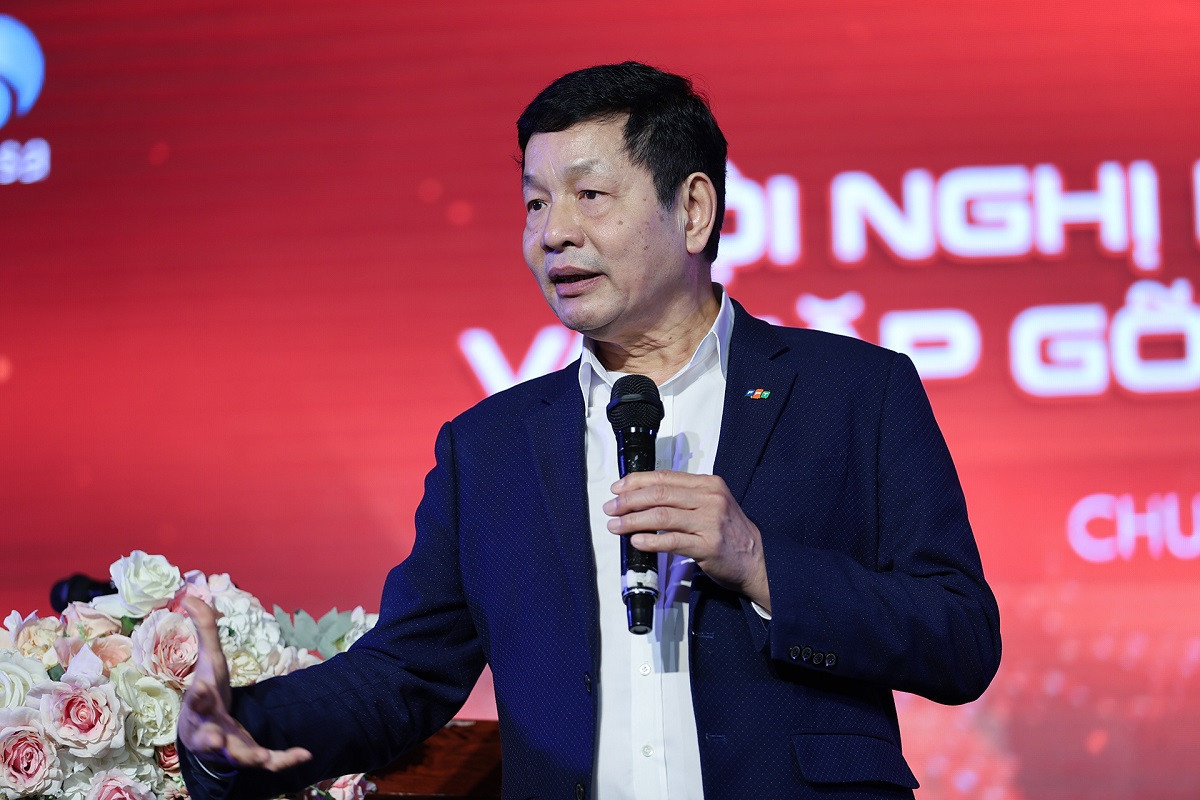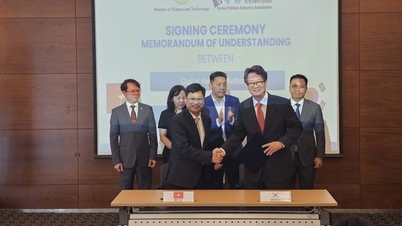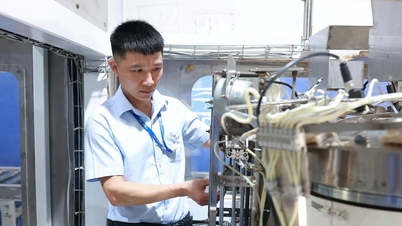“About 25 years ago, we had a dream that was considered impossible, which was exporting software. This time with the semiconductor industry, it is not our dream but the world that chose us. We need to do it immediately,” said Mr. Truong Gia Binh.
The origin of the story of Vietnam being selected Hundreds of businesses attending the VINASA Member Meeting event in early Spring 2024 were inspired by Mr. Truong Gia Binh, Chairman of the Founding Council of the Vietnam Software and IT Services Association (VINASA), Chairman of the Vietnam Semiconductor Industry Committee (SIV), telling a number of stories showing Vietnam's great opportunities in the semiconductor industry. 



Mr. Truong Gia Binh, Chairman of the Vietnam Semiconductor Industry Committee - under the Vietnam Software and Information Technology Services Association, shared many inspirational stories for Vietnamese businesses. Photo: Le Anh Dung
Highlighting the role of the semiconductor industry in determining world order, Mr. Binh cited the story of Intel - an American corporation that once struggled before maintaining its position as a "chip manufacturing giant" for decades: "The CEO of Intel gave me a book he called "The Bible of Intel Corporation", which recounted the period when Intel was "pushed into a corner" by Japanese corporations. The American corporation had to sell its chips below cost but still could not sell them because the price was still higher than 4 large Japanese factories, including Toshiba and Sony". Information that surprised many people was shared by Mr. Binh: The Japanese, with their innovative minds, at one point surpassed the US in the chip manufacturing industry. In the 80s and 90s of the last century, the Japanese economy was no longer far behind the US economy; Japan was ready to confront the US in the "chip war" to maintain its position as "hegemon" in the world. However, after Toshiba sold its propeller production line for Russian submarines, Japan had to lose its leading advantage in the chip industry. To maintain its "hegemonic" position, the US cooperated with South Korea and Taiwan (China). Thanks to extraordinary efforts, today, these two places produce almost all of the world's chips. In the context of semiconductor electronic devices all using chips produced in the same region, either China, Taiwan (China), or South Korea, if an incident occurs, the entire large region will "freeze". Not accepting such risks, the US chose a new partner: Vietnam. However, at present, many Taiwanese (China) semiconductor companies have not chosen Vietnam, because after surveying, they found that Vietnam's semiconductor human resources are almost zero, plus Vietnam has difficulty ensuring electricity production and clean water. “We are still in a 50-50 situation,” Chairman Truong Gia Binh analyzed the chance of getting the nod from Taiwanese (Chinese) semiconductor companies. The path Vietnam can take . Discussing the path Vietnam can take, Chairman Truong Gia Binh cited two stories. “I went to a chip design company. They have 600 employees, 20 years of establishment, nearly 900 million USD in sales, and their market value is nearly 8 billion USD. They told me they are not a chip manufacturing or chip design company, but a chip processing company for the world's leading corporations. When they used the word “outsourcing”, I felt we had a path,” Mr. Binh said. An important detail: 70% of the chip design company's workforce is in China. If the US wants to buy its chips, this chip design company needs to find more than 400 employees outside of China to meet the US's “soft barrier”. Answering Mr. Binh's question: "How long does it take you to train someone from a software engineer to a chip designer?", the leader of the chip design company said: "18 months". But Mr. Binh thinks differently: A software engineer who studies for 18 months can do everything related to chip design. However, when the detailed design is clearly divided, he only needs to study for 3 months to know how to do it right away. The precedent is that software exporters used to divide new technologies into small parts, learning while doing. "I believe all of you here can very quickly switch to studying chip design to take advantage of the opportunity to "outsource", even making chips for big companies like Intel, Qualcomm... When you do many chip design programs like that, you will accumulate a lot of IP (intellectual property). For example,FPT recently made a commercial chip, so it started to have IP that can be sold cheaply into the process of making all the chips in the world", Mr. Binh emphasized.
According to Chairman Truong Gia Binh, "outsourcing" and AI chips are the paths Vietnam can take. Photo: Le Anh Dung
“Outsourcing” is the first story. Continuing the second story: Manufacturing chips with integrated AI (artificial intelligence). “About 26 years ago, a group of 3 engineers opened a Samsung computer to look at the chip and affirmed that they could produce the same chip, even at a price about 30% cheaper. And then they founded MediaTek. Today, the market value of this company is 60 billion USD. I went to meet the founder of MediaTek, he proposed to establish a joint venture. I immediately agreed, but suggested manufacturing AI chips, not chips in general,” Mr. Binh continued the story. The Chairman of the Vietnam Semiconductor Industry Committee envisions the future: Chips are getting smarter and smarter. Taiwan (China) is very good at hardware, but in AI, it is still not a formidable opponent. Vietnam's strength is that the AI team will design AI chips that become smarter the more they are used. “We can learn from MediaTek’s idea: All the chips that others have made, we can make at a cheaper price. Or we can also think of completely new chips, we make and sell them ourselves,” Mr. Binh drew the path that Vietnam can take in the coming time. Connecting global forces, quickly “catching the trend” The next question: Having a path, how to go quickly so as not to miss the opportunity? The solution is in another story by Chairman Truong Gia Binh: “When I went to the US, I knew a group of people who had been making chips for about 20-30 years, and had taught semiconductors to many students who are currently working at chip design companies. Their income is about 100-300 thousand USD. They are willing to leave large US semiconductor companies such as Intel, Qualcomm, Amkor... to work for Vietnam. If you add up all the Vietnamese people making chips in the world, the number is not small. One of the tasks of the Vietnam Semiconductor Industry Committee is to establish sub-committees in different countries, even sub-committees in each city to gather the brothers and sisters together. We have to go to many countries, regularly connect, gather global forces to do things of world-class importance, not just for Vietnam alone.” Regarding the story of chip human resources, Mr. Binh added: Taiwan (China) inaugurated 14 new chip factories this year, building 40 factories in total. They are building a new chip power and are lacking human resources. A leading Taiwanese company in the chip sector said that it can only meet about 50% of the demand for human resources, although the Taiwanese government has implemented many funding programs for schools to build laboratories and provide funding to train human resources. They are willing to accept Vietnamese people if we can quickly send suitable people. With a deep understanding of the semiconductor industry, Mr. Binh advised: The semiconductor industry will bring many opportunities for Vietnamese digital technology businesses, especially in the stages: Design; testing; cooperation with international businesses... An American semiconductor company that manufactures chips in Taiwan (China) is having to bring them back to the US for testing, then ship the chips back to Taiwan for machine assembly. They are willing to place orders if Vietnamese businesses can undertake chip testing. This is an opportunity that Vietnamese businesses can start working on right away.
The head of the Vietnam Semiconductor Industry Committee said that in the coming time, the Committee will regularly connect and gather global forces to do world-class work. Photo: Le Anh Dung
The head of the Vietnam Semiconductor Industry Committee observed that Vietnam is still at risk of falling into the “middle-income trap”. If we resolutely “catch the trend” of the semiconductor industry, we can escape that “trap” and stand among the most advanced nations in the world. “About 25 years ago, we had a dream that was considered impossible, which was software export. Fortunately, that dream has come true. Vietnam has become the world's number 2 software exporting country, after India. However, we wasted the first 5 years after launching software export, FPT was "completely alone" because other Vietnamese enterprises hesitated to wait and see how the situation would develop. This time with the semiconductor industry, it is not our dream but the world chose us. We need to do it immediately, not wasting a single month, a single day, or an individual hour. If we make the mistake of wasting time again, it will ruin a big thing,” Mr. Binh shared his thoughts.| Minister of Information and Communications Nguyen Manh Hung: "Vietnam will turn itself into a world hub for semiconductors, first of all a hub for semiconductor human resources, then hubs for semiconductor design, assembly, testing, packaging... To quickly have human resources to meet the requirements, the fastest way is to coordinate businesses with universities. The State will support labs and licenses for chip design." |
| The Vietnam Software and Information Technology Services Association (VINASA) has just established the Vietnam Semiconductor Industry Development Committee (SIV) under the Association to gather experts, businesses, domestic and international partners and other necessary resources to promote the semiconductor industry in Vietnam. The Committee will focus on implementing the tasks of advocacy, policy development, training and development of human resources, disseminating knowledge and experience, enhancing cooperation, and developing markets for digital technology enterprises participating in the global semiconductor industry value chain. |
Vietnamnet.vn
Source









































![[Photo] Solemn opening of the 12th Military Party Congress for the 2025-2030 term](https://vphoto.vietnam.vn/thumb/1200x675/vietnam/resource/IMAGE/2025/9/30/2cd383b3130d41a1a4b5ace0d5eb989d)
![[Photo] The 1st Congress of Phu Tho Provincial Party Committee, term 2025-2030](https://vphoto.vietnam.vn/thumb/1200x675/vietnam/resource/IMAGE/2025/9/30/1507da06216649bba8a1ce6251816820)
![[Photo] Panorama of the cable-stayed bridge, the final bottleneck of the Ben Luc-Long Thanh expressway](https://vphoto.vietnam.vn/thumb/1200x675/vietnam/resource/IMAGE/2025/9/30/391fdf21025541d6b2f092e49a17243f)
![[Photo] President Luong Cuong receives President of the Cuban National Assembly Esteban Lazo Hernandez](https://vphoto.vietnam.vn/thumb/1200x675/vietnam/resource/IMAGE/2025/9/30/4d38932911c24f6ea1936252bd5427fa)



























































Comment (0)